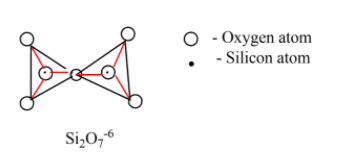
Pyrosilicates is also called as:
(A) Chain silicates
(B) sorosilicates
(C) sheet silicates
(D) cyclic silicates
Answer
494.7k+ views
Hint: The basic building block of silicate minerals is the
Complete step by step solution:
Silicates are the mineral containing silicon and oxygen in tetrahedral
Some of the examples of silicates are feldspar, zeolites, mica, and asbestos. The important man-made silicates are glass and cement.
When silicate chains are linked together, they form chain, ring, sheet, or three-dimensional structures. The negative charge on the silicate structure is neutralized by positively charged metal ions. If all four corners are shared with other tetrahedral units, their dimensional networks are formed.
Depending on the way the tetrahedral units are linked, the silicates are classified into the following types:
(1) Orthosilicates
(2) Pyrosilicates
(3) Cyclic silicates
(4) Chain silicates
(5) Double chain silicates
(6) Silicon sheets or phyllosilicates
(7) Three-dimensional silicates
Pyro silicates: these type of silicates contain

Based on the structure of the above pyrosilicates are also known as soro silicates or disilicates.
So, the correct answer is option B.
Note: Silicates are common minerals in the earth crust since silicon and oxygen are abundant elements. The oxygen to silicon ratio represents the degree of polymerization. Grater will be the degree of polymerization that decreases the oxygen to silicon ratio. The basic silicates minerals readily react with weak acids.
Complete step by step solution:
Silicates are the mineral containing silicon and oxygen in tetrahedral
Some of the examples of silicates are feldspar, zeolites, mica, and asbestos. The important man-made silicates are glass and cement.
When silicate chains are linked together, they form chain, ring, sheet, or three-dimensional structures. The negative charge on the silicate structure is neutralized by positively charged metal ions. If all four corners are shared with other tetrahedral units, their dimensional networks are formed.
Depending on the way the tetrahedral units are linked, the silicates are classified into the following types:
(1) Orthosilicates
(2) Pyrosilicates
(3) Cyclic silicates
(4) Chain silicates
(5) Double chain silicates
(6) Silicon sheets or phyllosilicates
(7) Three-dimensional silicates
Pyro silicates: these type of silicates contain

Based on the structure of the above pyrosilicates are also known as soro silicates or disilicates.
So, the correct answer is option B.
Note: Silicates are common minerals in the earth crust since silicon and oxygen are abundant elements. The oxygen to silicon ratio represents the degree of polymerization. Grater will be the degree of polymerization that decreases the oxygen to silicon ratio. The basic silicates minerals readily react with weak acids.
Recently Updated Pages
Master Class 11 Economics: Engaging Questions & Answers for Success

Master Class 11 Business Studies: Engaging Questions & Answers for Success

Master Class 11 Accountancy: Engaging Questions & Answers for Success

Master Class 11 English: Engaging Questions & Answers for Success

Master Class 11 Computer Science: Engaging Questions & Answers for Success

Master Class 11 Maths: Engaging Questions & Answers for Success

Trending doubts
State and prove Bernoullis theorem class 11 physics CBSE

1 ton equals to A 100 kg B 1000 kg C 10 kg D 10000 class 11 physics CBSE

State the laws of reflection of light

One Metric ton is equal to kg A 10000 B 1000 C 100 class 11 physics CBSE

1 Quintal is equal to a 110 kg b 10 kg c 100kg d 1000 class 11 physics CBSE

Difference Between Prokaryotic Cells and Eukaryotic Cells




